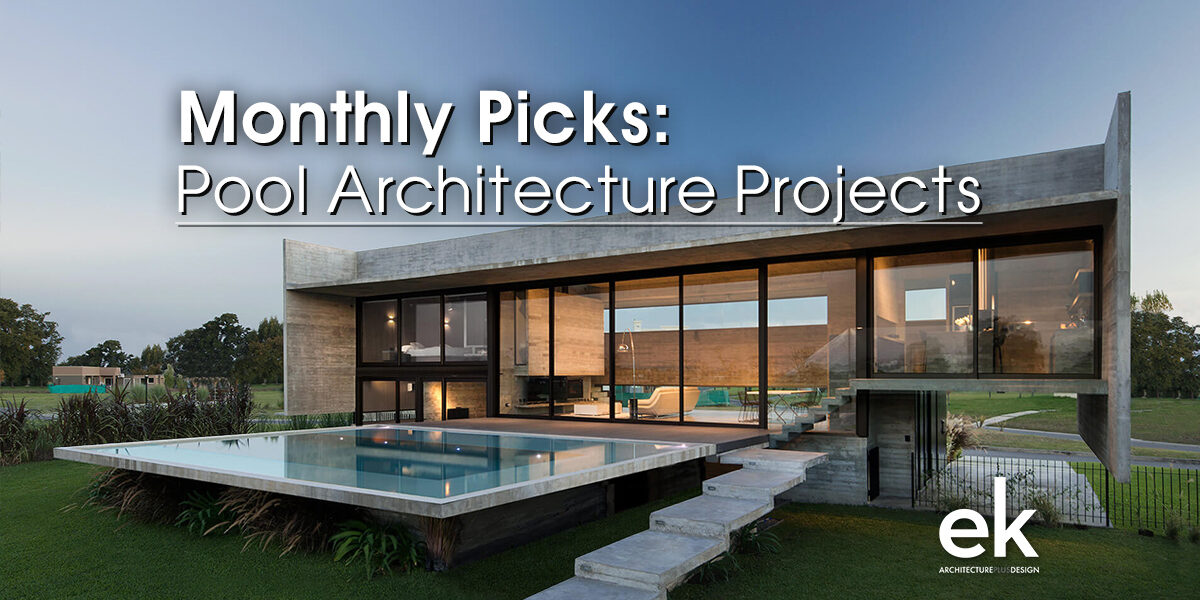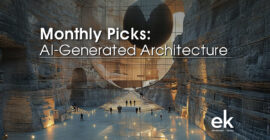The editorial team of ek magazine selected ten architectural projects, featured in past print issues as well as the ek website, that showcase exceptional pool designs
ek Issue: 282 | November 2023
The 5-star hotel in Mykonos was conceived around the central idea of the endless motion of the sea’s waves and the creatures that inhabit its depths. Through a series of architectural gestures -including the abstract composition of solid forms, the emulation of natural elements, and the reinterpretation of traditional Mykonian architectural language- the project took its final shape. The overall composition evokes the curves of the sea, with the entire building embodying fluidity at its core -as if a giant sea creature had emerged from the earth, shaping the volumes with its body and tail. The building’s organic form subtly references the typologies, shapes, and silhouettes of Cycladic architecture. Elements of the Mykonian landscape -dry stone walls, the sea, rocks, and arid vegetation- have been integrated as architectural details, offering a variety of textures and spatial experiences.
Inspired by the geophysical forces that shape the island’s character, this residence in Tinos reinterprets the encounter between stone and air -an encounter that leaves its mark on the land’s morphology. Where air and stone collide, one element always prevails: either forming linear projections or shaping cavities enclosed by stone. This dynamic, minimalist residence expresses these spatial qualities, negotiating the parallel relationship between openness and introversion -between visibility and shelter- and exploring how space is experienced. The design creates vantage points and protective cavities that emerge both from within and above the terrain. The client envisioned a personal retreat: a place of seclusion with nothing more than a long, narrow pool for exercise and a sheltered sleeping area.
Located on a three-quarter-acre parcel with views of the Las Vegas Strip to the east and Red Rock Canyon to the west, this site endures strong winds, cold, dry winters, and harsh, hot summers with monsoon rainstorms. Protection from the sun and wind, as well as durability and privacy were the simple constraints that shaped the formal direction and materiality of the house. The residence repeats the spare behavior of the desert in material and form. A subtractive process left a wind-protected court to the east and provided an opportunity for an elevated basin of water that mirrors the dimensions of the living space. The distant view of the city calls out its ephemeral nature and delicate relationship with water. Entry to the house is gained via a narrow opening in the concrete mass. The threshold, at eye level with the water, leads to a closed and shaded passage that ramps up slightly to an entry court, open to the sky and inhabited by a vertical landscape of native plantings. The architecture represents a contextual conversation between the desert landscape and the city.
The holiday home on the Greek island of Paros blends a subtle modernism with both contemporary and traditional detailing and materials. Assembled as a linked series of standalone rooms around a poolside courtyard, the villa touches the landscape lightly, providing a beautiful and simple luxury living environment in its natural Aegean setting. Rising above an olive grove on the west side of Paros, this residence is centred on the setting of the August sun. The solar axis is described by a linear path that terminates at a negative-edge pool cantilevering into the Aegean blue. This linearity is mirrored by the adjacent pergola -a gently undulating wave of bamboo, punctured by a single oculus that brings light onto a chiselled marble poolside lounge. The volumes gently touch upon the earth on overlapping terrazzo slabs, “floating” above the soil.
ek Issue: 269 | July-August 2022
The new resort, located near Messaria, seamlessly blends old and new aesthetics. The project refurbishes existing hotel units and connects them with new structures, resulting to a total capacity of 121 rooms. The outdated functional layouts are being reimagined in favour of a cohesive, modern design that views the surrounding landscape as a key element. The reception is accessed through a garden filled with climbing plants, providing ample shade. A suspended pergola made of wire mesh discreetly hides its supports and plant trunks. On either side of an accessibility ramp, a water path flows over stepped lava slabs, paying homage to the island’s volcanic history. The reception itself is an open structure adorned with billowing curtains. The main pool begins at the entrance, framing a stunning view of the sea, and follows a curved path towards the restaurant, forming an artificial beach-like area. Natural materials dominate the water area: at the pool bar, makuti covers the lower part on the pergolas, while the restaurant roof features illuminated wicker baskets. The presence of nature continues in the upstairs bar, which boasts a large, planted wall, as well as on the terrace, where new metal pergolas support an array of climbing plants.
The new 5-star hotel complex is situated on a stunning peninsula nestled between Ipsos Bay and Dassia Bay. Spanning a unique 245-acre plot characterized by varied terrain, the design features clean geometric forms. The harmonious proportions of the low building volumes, defined by their simple lines, embody the project’s architectural principles. The resort features 390 rooms and suites distributed across ground-floor as well as two-story buildings, organized into four sections. At the center lies the grand reception building, which hosts the main public areas, including the reception desk, a spacious lobby and bar, and a shopping arcade. Abundant greenery, found in suspended gardens and large atriums, both separates and unites the various spaces. The Flavors restaurant is situated on the ground floor of the main building, while two additional themed restaurants -one Asian and one Peruvian- are located on the first floor. The resort also features four independent themed restaurant buildings, each with a distinct character, scattered throughout the property. Other amenities include a spa with an indoor pool offering scenic views, an open-air theatre, a teenage-activities building, and a daycare facility. The surrounding area boasts four bars, various sports facilities, four communal pools for adults -each paired with a children’s pool- an aquatic playground, an administration building, and finally, additional amenities.
Escobar House is located in Haras Santa María de Escobar, a gated community in the North corridor, approximately 54 km from the center of Buenos Aires. The neighborhood’s expansive lots are arranged around a golf course. The site for Escobar House is defined by its flat topography and a privileged rear view towards the golf course and a vast green area oriented to the North. Designed for a young couple, the residence was conceived as a weekend house that would eventually become their permanent home. The social area, envisioned as the heart of the house, was designed with a higher ceiling and elevated above the natural terrain to capture sweeping views of the surrounding landscape. The brief included an en suite master bedroom, two additional bedrooms for future children, and a playroom located as far as possible from the social area. The living and dining spaces open onto a semi-covered terrace adjacent to the swimming pool, allowing the house to connect seamlessly with its natural surroundings.
The boutique resort in Agia Pelagia, built along a rocky peninsula, consists of 49 suites and villas. It was designed as an elegant and secluded retreat, with unobstructed views and complete privacy. The building’s architecture perfectly integrates it with the rocky landscape, placing it in constant dialogue with nature through the choice of materials, textures, and colors. The hotel’s design draws inspiration from the harmonious blend of organic traditional and contemporary elements, infused with the raw character of the Cretan landscape where it is built. During construction, natural materials, such as the local Mylopotamos stone and the antique Egyptian Sinai marble were used for the flooring, while Phaistos marble was used for the custom-made furniture placed throughout the different rooms. All metallic components are painted in rusty tones and have Corten details, while the sound-insulating hidden aluminum frames frame the sea through large windows, allowing plenty of natural light to fill the interior spaces. Woods such as chestnut from Mount Athos, reed wicker, solid oak and niangon complete the composition, while coats of polished concrete in earthly tones are used for the interior walls.
Located in the area of Analipsi, just 25 km east of Heraklion, the Stella Island Resort & Spa is a luxurious five-star resort. Its concept is unique by European standards, with water serving as the central theme and design focus. The site’s relatively long distance from the shore and its nearly flat terrain inspired the creation of a bold master plan centered around water. As a result, the buildings -including the guest room wings and communal spaces- are arranged around an expansive, free‑form pool of approximately 5,000 m². Every structure has direct access to the water, creating the illusion of a floating hotel. At the heart of this “Lagoon” are the main common areas, designed as islands connected by wooden walkways and bridges. Together with the wooden platforms outside each room, serving as private terraces, this design gives the resort its distinctive character: a series of wooden, stilted structures suspended over the water. The scene is completed by timber superstructures -decorative sunshades attached to the facades and supported by tall, cylindrical columns that rise from the water. The landscaping, featuring primarily palm trees, adds an exotic and tropical atmosphere.
On the southern side of Mykonos, in the area of Kalafatis with a view of the sea and Tragonisi, this single-story residence of 200 m² stands out for its clean, square lines and sleek, minimalist volumes. The design revolves around a captivating interplay of geometry between crisp, perforated white volumes, natural stone, and water surfaces. The master plan is composed of two U‑shaped elements -the building and the pool- which embrace one another, creating the impression that the residence is floating on water. The layout is divided into two sections: the living spaces and the bedrooms, separated by a central swimming pool. Upon entering through the double wooden door, one is met by a serene water feature with three concrete and granite “floating” steps that lead to the bedroom wing. The living area, located on the southern side, is framed by sliding glass doors that open to the pool. At the rear, a large sliding glass door connects the living area to a cactus‑planted courtyard, creating a seamless indoor‑outdoor space where the pool becomes an integral part of the experience -an intimate, sheltered, and idyllic heart of the home.















